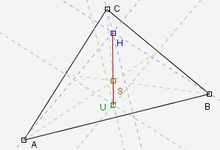Dynamic geometry

Under dynamic geometry refers to the interactive creation of geometric constructions on the computer . With geometrical constructions are meant classical constructions with the compass and the ruler , as they are studied in mathematics since antiquity (e.g. in the books of Euclid ). What is meant here are not CAGD (Computer Aided Geometric Design) or architectural drawings, but geometry as a mathematical discipline. Movements, deformations and kinematics can be illustrated in this way. The main place of application of dynamic geometry is geometry lessons in schools.
History and characteristics
The main development step in dynamic geometry was the pull mode introduced in the late eighties / early nineties , which was realized by the first dynamic geometry software products such as Cabri Géomètre and Geometer's Sketchpad. The dynamics come into play because free base points can be moved / dragged in the so-called pull mode and all of the dependent constructed objects change their position accordingly. In this way, on the one hand, the correctness of constructions can be checked in different initial situations, and on the other hand, dependencies can be recognized that would not be visible in a static construction. Locus lines can be created as an important application using the track mode. With the dynamic recalculation of points, the graphic representation is not deleted at the old positions, and the points leave a trace on the locus on which they move.
The tools compass and ruler are simulated by the computer. The computer can also generate points of intersection, and there is an abundance of other tools, such as plumb bobs and parallel rulers, which simplify the construction steps, depending on the software with different weightings . Macros are used in many programs to simplify the construction process and are part of the standard repertoire.
New developments and updates since the late 1990s are increasingly highlighting additional aspects. This includes non-Euclidean geometries , the connection to computer algebra , possibilities of numerical influence on the constructions and much more. Another development is the integration of the DGS (dynamic geometry software) into the internet work environment. More and more products offer (mostly based on Java ) implementations of how to put the generated worksheets online. There are also implementations on various graphical pocket calculators .
Since the 2000s, dynamic spatial geometry has also emerged as a sub-branch of dynamic geometry. Here, the 3D capabilities of modern PCs are used to illustrate three-dimensional facts of analytical geometry.
Well-known software for dynamic geometry
The well-known DGS that have existed since the early 1990s include Cabri Géomètre , Geometer's Sketchpad , Euclid and Geolog . Euclid developed into the meanwhile best-known DGS in Germany in the school sector. Geolog was also well known in Germany and had a special tutoring system to make it easier for students to learn geometric constructions and teaching content. With Geometer's Sketchpad, Cabri Géomètre was the first internationally known DGS and, like Geometer's Sketchpad, is not only available on a PC but also on TI calculators. The Cabri3D, developed much later, was one of the first spatial DGS. With the exception of Geolog, all of the above DGS are sold commercially.
Since the end of the nineties, GeoGebra (since 2001), Geonext (1999–2007), Cinderella (since 1998) and Zirkel und Lineal (since 1995), a number of Java-based systems have been developed in the German-speaking area , which, in contrast to the earlier DGS were no longer limited to a specific operating system . In addition to the usual geometric-visual manipulation of objects, GeoGebra also offers an algebraic interface, making it the first program that combines the properties of computer algebra and dynamic geometry. Cinderella offers the possibility of working with non-Euclidean geometries and is the only one of the Java-based systems to be sold commercially, although a free full version for private use has also been available since the end of 2013. Kig is a free DGS that is widely used on Linux.
literature
- Andreas Koepsell, Dirk Tönnies: Dynamic geometry in mathematics teaching lower secondary . Aulis 2007, ISBN 978-3761427200
- H.-J. Elschenbroich: Geometry movable with Euclid . Dummler 1996.
- James Richard King, Doris Schattschneider: Geometry Turned On !: Dynamic Software in Learning, Teaching, and Research . Cambridge University Press, 1997, ISBN 0883850990
Web links
- Oliver Labs: Dynamic Geometry - Fundamentals and Applications (script) (PDF file; 6.25 MB)
- Jürgen Roth. Dynamics of DGS - why and how should they be used? in conference proceedings 2005 of the AKMUI (PDF file; 6.68 MB)
- Dynamic symmetries with Kig (lesson example )
- Dynamic geometry pages by HJ Elschenbroich
- The Intergeo project for the dissemination of dynamic geometry in Europe
